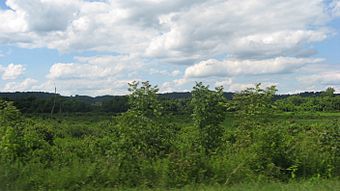Clover Site facts for kids
|
Clover Site (46CB40)
|
|

Looking toward the site from the south
|
|
| Lua error in Module:Location_map at line 420: attempt to index field 'wikibase' (a nil value). | |
| Location | Lesage, West Virginia |
|---|---|
| NRHP reference No. | 92001881 |
Quick facts for kids Significant dates |
|
| Added to NRHP | April 27, 1992 |
| Designated NHL | April 27, 1992 |
The Clover Site (also known as 46CB40) is an important archaeological site in West Virginia, United States. It's located near Lesage in Cabell County. This site holds the well-preserved remains of an ancient Native American village. This village belonged to the Fort Ancient culture and existed a long time ago, before Europeans arrived.
The special things found at the Clover Site have helped experts understand a specific time period. This period is called the Clover Phase of the Fort Ancient culture. Because of its importance, the Clover Site was named a National Historic Landmark in 1992.
Contents
What is the Clover Site?
The Clover Site is about 20 kilometers (12 miles) north of Huntington. It sits on a high, flat area near the Ohio River. This area is now part of the Green Bottom Wildlife Management Area. The ancient village was quite large, covering about 5 acres.
How the Village Was Designed
The village had a semi-circular shape. In the middle, there was an open area called a plaza. Houses and living spaces were built around this central plaza. This layout was common for other Fort Ancient villages. However, archaeologists have not yet found a protective wall, called a palisade, around the Clover Site. Other Fort Ancient villages often had these walls.
What Archaeologists Found
When archaeologists explored the site, they found many interesting things. They discovered pottery made by Native Americans, which often had crushed shells mixed in. They also found tools made from stone and bone. Many beautiful ornaments were uncovered too.
Some very special finds were items made by Europeans. These included brass and copper ornaments, as well as glass trade beads. These European items are important because they help experts know exactly when the upper parts of the site were used. They show that people lived there during a time called the protohistoric period, around the late 1500s.
Studying the Past
People have been studying the Clover Site for a long time. In the 1920s, amateur archaeologists like John J. Adams and S.F. Dunett found many artifacts. Later, in the 1940s, a professional archaeologist named James B. Griffin led investigations. The items found helped Griffin suggest the "Clover Phase" of the Fort Ancient culture. This phase helps identify other similar sites from the years 1550 to 1600.
More recently, in the 1980s, Nicholas Freidin from Marshall University also worked at the site. He even taught archaeology students there from 1984 to 1988. Today, many of the artifacts found at the Clover Site are kept safe. They are part of the John Adams Collection at the Huntington Museum of Art.

